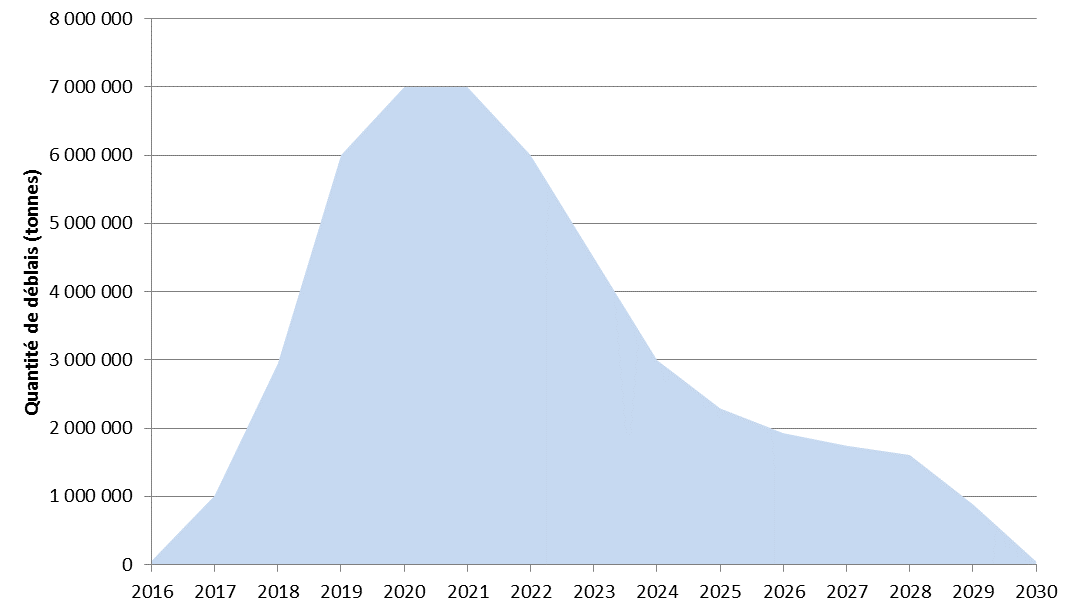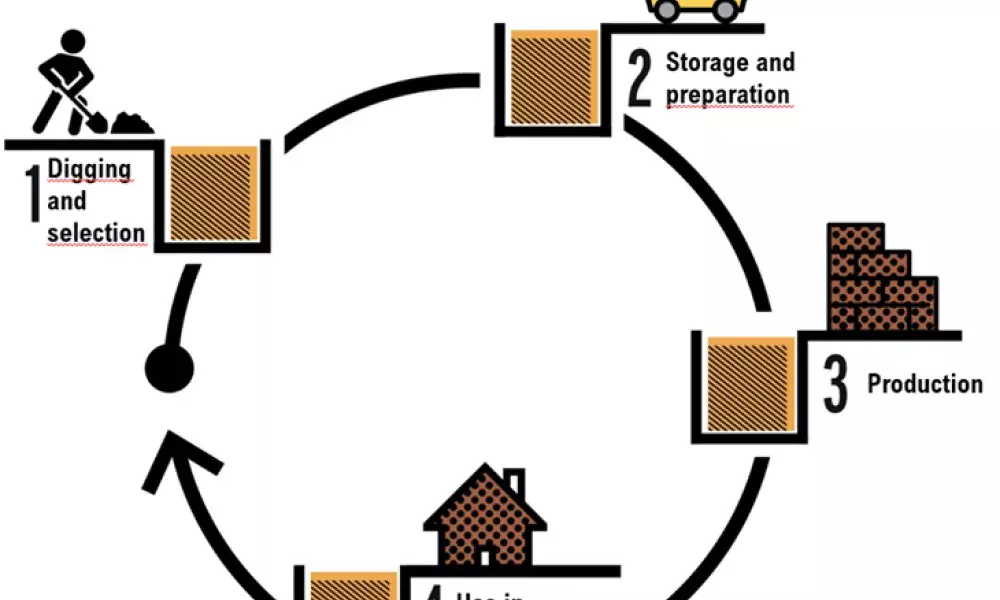
Executive summary
The implementation of Cycle Terre: Earth Cycle project, co-financed by Urban Innovative Actions (UIA), is over. The factory of earth construction materials was achieved. The production is ongoing. A cooperative company for the development of this process has also been created. This management solution was selected after analysis of many options.
The Earth Cycle model is based on the use of excavated soil from major construction sites to produce construction materials. Is this model sustainable from an economic point of view? This is one of the major questions for the coming years. Many factors can impact this future. They are discussed in this journal. In the end, the project is a success as an innovative pilot; the fundamental question is how to ensure the long-term sustainability of this major innovation.
In this fourth journal, we will discuss and analyze in depth the challenges identified as important to implement an urban innovative project. As already described in previous articles, Earth Cycle is an innovative project as it is implementing an industrial activity in a city and trying to develop a new circular economy approach for a sustainable earth management system.
In the first part of this journal, we describe the situation of Earth Cycle after the achievement of the factory implementation and at the end of the project, along with some analyses and observations. Secondly, this paper will present the analyses and assessments of the challenges faced by an innovative project. This exercise allows demonstrating that the development potential of Earth Cycle is important but still the next stage of development without the UIA support is very sensitive for the medium and long-term perspective. Finally, lessons learned from the implementation of this project are presented as well as recommendations for launching similar initiatives. It opens the discussions on the way of using and integrating in a sustainable manner earth as a construction material.
The implementation of Cycle Terre: Earth Cycle project, co-financed by Urban Innovative Actions (UIA), is over. The factory of earth construction materials was achieved. The production is ongoing. A cooperative company for the development of this process has also been created. This management solution was selected after analysis of many options.
The Earth Cycle model is based on the use of excavated soil from major construction sites to produce construction materials. Is this model sustainable from an economic point of view? This is one of the major questions for the coming years. Many factors can impact this future. They are discussed in this journal. In the end, the project is a success as an innovative pilot; the fundamental question is how to ensure the long-term sustainability of this major innovation.
In this fourth journal, we will discuss and analyze in depth the challenges identified as important to implement an urban innovative project. As already described in previous articles, Earth Cycle is an innovative project as it is implementing an industrial activity in a city and trying to develop a new circular economy approach for a sustainable earth management system.
In the first part of this journal, we describe the situation of Earth Cycle after the achievement of the factory implementation and at the end of the project, along with some analyses and observations. Secondly, this paper will present the analyses and assessments of the challenges faced by an innovative project. This exercise allows demonstrating that the development potential of Earth Cycle is important but still the next stage of development without the UIA support is very sensitive for the medium and long-term perspective. Finally, lessons learned from the implementation of this project are presented as well as recommendations for launching similar initiatives. It opens the discussions on the way of using and integrating in a sustainable manner earth as a construction material.
The project, its development and the current situation
One of the major topics in relation to circular economy in the Paris region is the management of excavated soils. In fact, soil is a major aspect of the law Climate and Resilience approved on 21st August 2021 (https://www.legifrance.gouv.fr/jorf/id/JORFTEXT000043956924). This law introduces the importance of soil as a resource and the latter should be valorized. It also converges with the importance given to circular economy in French territories and cities. Soils have been disregarded for a long period but the challenges of climate change and carbon neutrality have reintroduced them as a major potential contributor to the ecological transition.
Paris region produces around 18 million tons of excavated earth per year. The creation of the Grand Paris Express (GPE) infrastructure and the related city planning operations will generate even greater production in the coming years: it is expected that 60 million tons will be generated by the Société du Grand Paris (SGP) by 2030. Another event has shown the importance of managing large quantities of soils: the construction of infrastructures dedicated to the 2024 Summer Olympics. The figure 1 shows the estimated quantities of excavated soils by SGP expected by 2030.
Figure 1: calendar of excavated earth (in tons) by 2030 - estimation SGP
Earth Cycle is an active contributor to implement the logic of circular economy in urban planning. Introducing earth as a material for construction, landscaping and urban design will reduce the ecological footprint and decrease the ‘artificialization’ and the waterproofing of our cities. The author of this journal believes in this approach of integrated management of earth in cities.
Earth Cycle proposes to reuse and to valorize the excavated earth to produce building materials with low environmental impact (figure 2). A raw earth materials factory located in Sevran was designed and built. This factory has been producing since autumn 2021 blocks of compressed earth, mortars and coating (see pictures 3 of the factory in Sevran).
The implementation of Earth Cycle has greatly helped the earthen construction sector in France and in the Paris region. Of course, other factors have been influencing the inclusion of raw-earth techniques in public policies, notably the launch of the National Project on Earthen Construction “PN Terre”.
The opening of the factory and the UIA label gave a very positive image. The French Environment and Energy Management Agency (ADEME), working notably on climate issues, has for instance started to include earthen techniques along bio-based solutions in the eligibility criteria of relevant calls for projects.
The creation of the Sevran pilot factory is, in our opinion, only a first step. The purpose of the UIA project is to test an innovative solution, by creating a knowledge base and skills in order to then be able to generalize it.
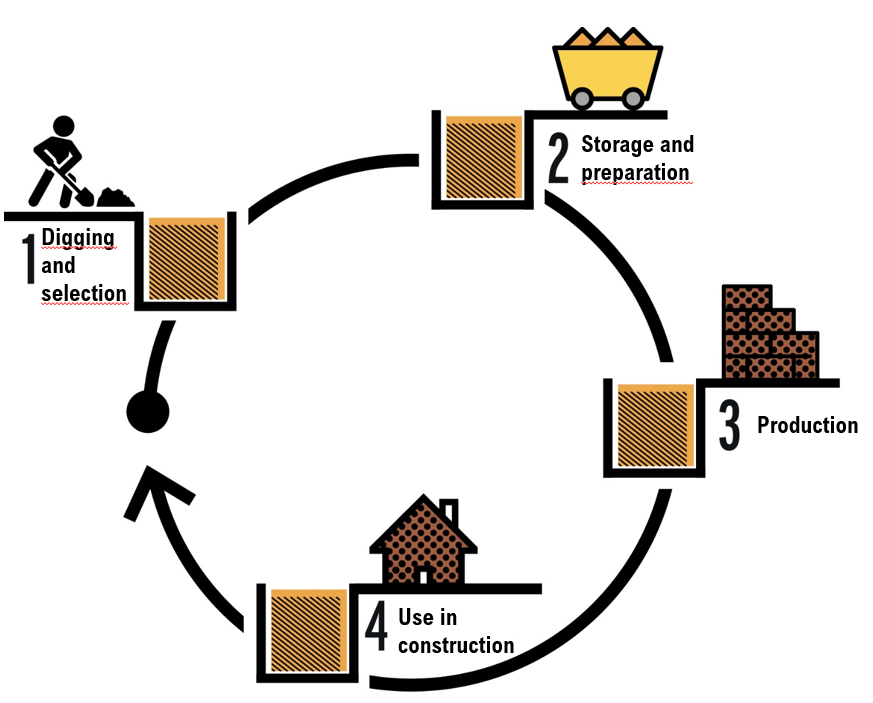
Figure 2: Earth Cycle, an integrated project in circular economy

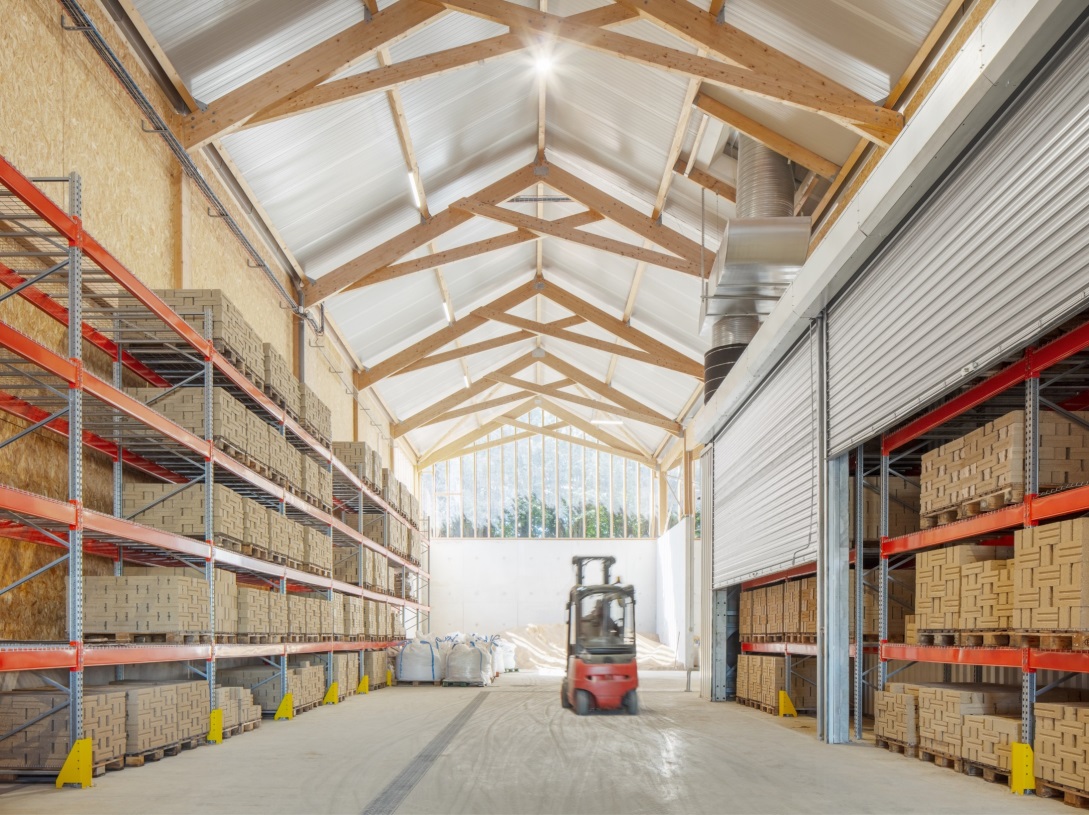
Pictures 3: The Earth Cycle factory in Sevran (major investment of the UIA project)
One of the objectives of this journal is to discuss Earth Cycle future challenges and what are the threats that might exist. A list of possible threats is indicated in this paragraph, which is based on the results of the analysis of UIA expert and the project final qualitative report submitted by the city of Sevran. The assessment of challenges in the light of criteria for an innovative urban project will be presented in the next section of this journal.
- The scaling-up: We observe a reluctance of other local authorities to invest in developing new factories like the one of Earth Cycle. This shows the importance of the UIA grant for a risky project (in terms of investment, operating costs, and technical constraints).
- The governance of the factory: The creation of a cooperative society to manage the factory is a very innovative idea as many private stakeholders invested in it. To have a sustainable economic model of this company, the market has to be more active, so that more quantities of products are ordered. The further involvement of new engaged clients seems to be necessary.
- The business model and the implication of actors: At this stage, the operating cost is high and the delivered products are not yet competitive from an economic point of view. To be competitive with other classic construction materials, a global cost analysis based on the environmental concerns has to be established. It is not only a question of financial cost, but also the environmental impact is crucial.
- The characteristics of available soils and the risk of inadequacy between their quality and production possibilities are important threats; probably more research on the material transformation would be necessary. The picture 4 shows the variety of soils in the Paris region, which means that the transformation processes are different and should be first tested and accredited. Earth Cycle established a list of criteria to select reliable materials:
- Maximum of cohesion à Mechanicals properties of final materials
- Minimum of shrinkage à Minimum of addition of sand and gravel
- Maximum of homogeneity à Large scale process and material certifications
- Availability of material in sufficient quantity (at the right time) à Production lines supply
- Minimum of water content à Minimum of energy, place and time for drying + Mechanical problems for crushing and mixing.
Pictures 4: the variety of soils in the Paris region
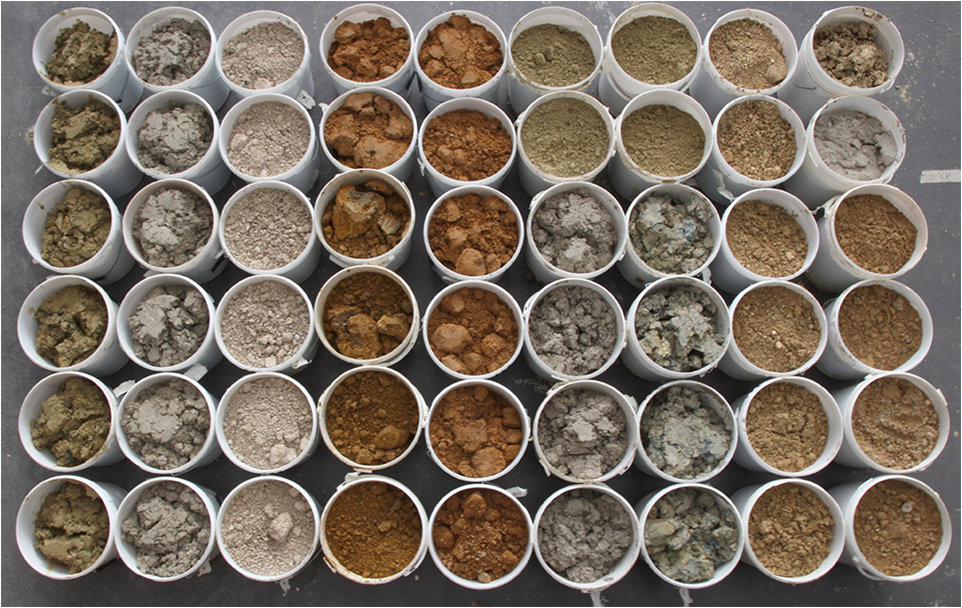
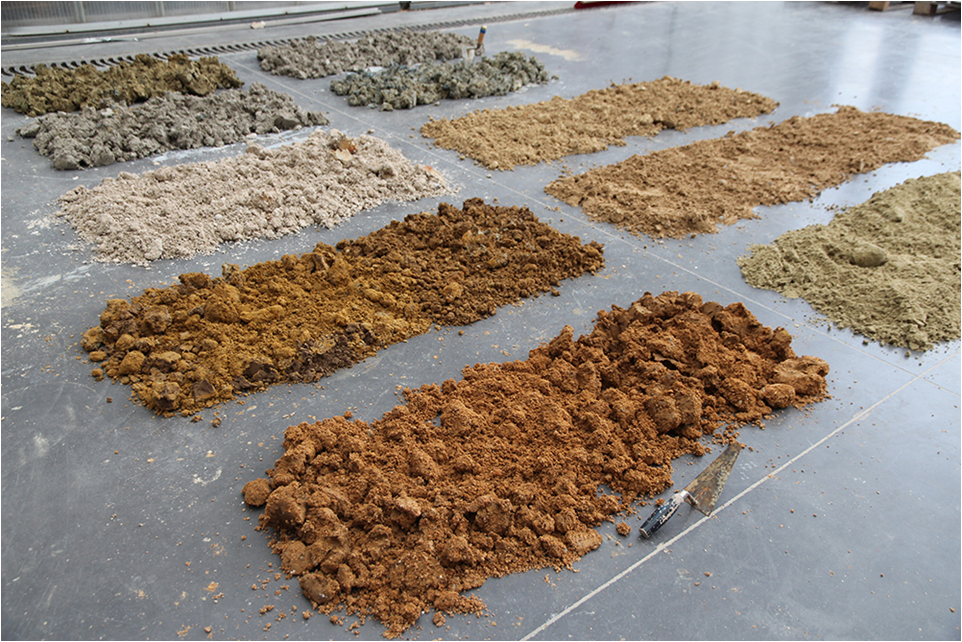
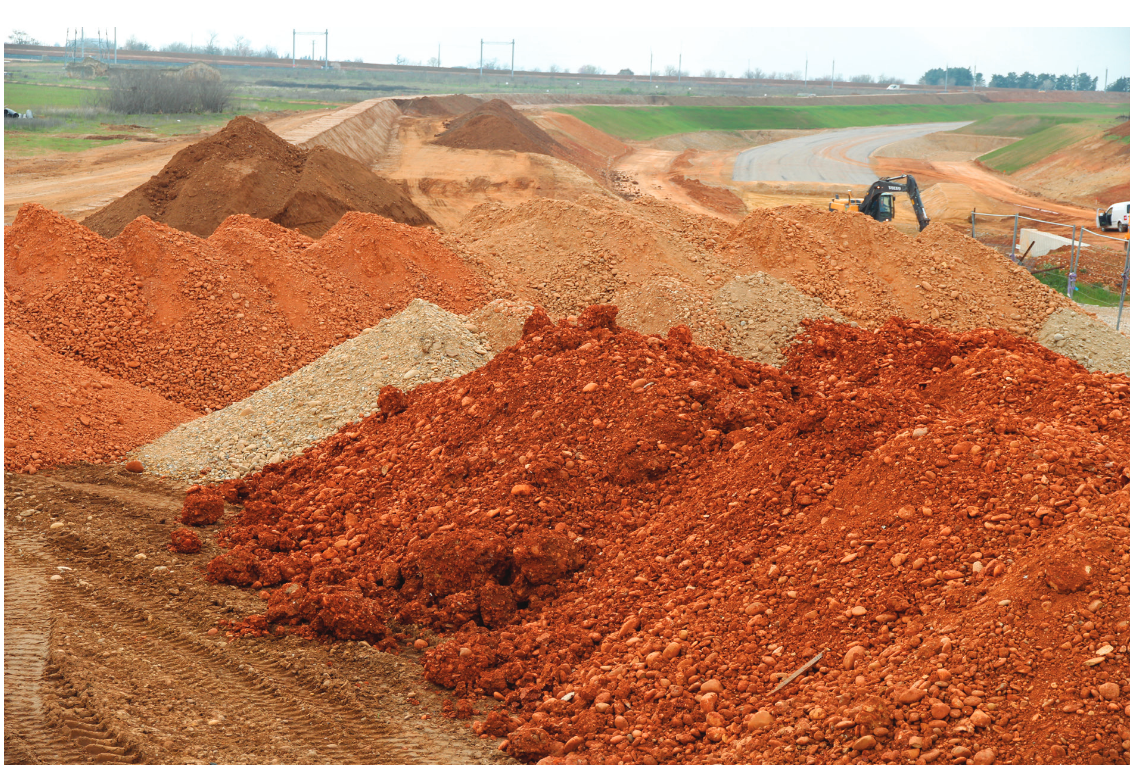
The quantities of produced materials from the factory, for the first year of operation, are acceptable.
- BTC (compressed earth block): 120.000 units, it is the equivalent to 40.000m² walls
- Coating: around 600 tons
- Mortar: around 200 tons
- Rammed earth (in big bags): around 500 tons
In the coming years, the quantity will be more important and the production of panels will be proposed for construction companies. At this stage, the accreditation process by the French government is not yet finalized. But the perspective is very positive.
Continuity and sustainability challenges
An overview of the UIA challenges as well as project specific challenges is presented in the table below. Besides the established UIA challenges, three more challenges were identified in our third journal: financial sustainability, technical readiness, and legislative readiness. We have added for this journal an additional specific challenge, which is the governance of the factory and the continuous involvement of the shareholders of the cooperative company. These extra four challenges are crucial for the long-term sustainability of Earth Cycle. The analysis of the challenges has been realized one year after the project end and considered the issues related to the governance of the cooperative company and the sustainability of the action once the UIA co-funded period is over. It has also integrated the situation of the construction and housing market in France and Paris region.
As mentioned earlier, Earth Cycle project is piloting a new technology for a new urban service with new business models and partnerships. For example, the involvement of the city of Sevran and the Ile-de-France region was very important during the design process and the final stage of the implementation. During the operating period, they were not involved any more in the management of the factory. The most probable reasons are related to the commercial character of the operating entity: on the one hand, it is difficult for local authorities to be a part of a commercial entity and on the other hand, the risk related to the financial sustainability of the factory is important. It must be underlined that neither the region nor the city is imposing conditions to encourage the use of earth as construction material for public construction works.
The flexibility and the high-level involvement of the private urban developer (QUARTUS Ensemblier Urbain) in the implementation phase was a very positive signal for the project sustainability and perpetuity. It is still the case with many projects to be implemented in the coming years but for the first year, the orders received did not meet the expectations. The future is bright but not the present! Between 2017 and 2021, only 6 projects using earthen techniques were built in the Paris region. In the year 2022, architects and construction companies submitted 157 requests for quotes to Earth Cycle regarding potential projects, which is an outstanding result compared to the previous years. Nevertheless, we do not have yet a precise assessment of the number of projects that will actually be carried out.
One more positive point is the mobilization of the researchers in the different fields of the project. Specialized teams in soil identification, earth construction and urban metabolism were involved and the achievements are innovative in the field of circular economy. For example, a very relevant assessment of flows needed for the production in the factory was realized. This assessment was a new approach in this field of circular economy. A collective book entitled Terres Urbaines: Valeurs positives pour les villes de demain (https://www.eyrolles.com/BTP/Livre/terres-urbaines-9782416008993/) was also published at the end of the year 2022 and Earth Cycle was a major contributor. This work has made it possible to mobilize all researchers working on earth management.
In the table below, different challenges are discussed and their impact is classified as follows:
-
High: important issues that are crucial for the factory and on which the management team has to focus during the coming years. If not resolved, they will impact the project legacy. As the project is finished, the 4 to 5 coming years are important to ensure the mid- and long-term sustainability. Some signals can be weak but at the same time viewed with alarm.
-
Medium: the team involved in the management of the factory has plans and solutions to face the difficulties and they are able to propose options for the project sustainability and continuity.
-
Low: the situation is under control. The factory and the concerned stakeholders have a plan or solution to mitigate or to face future difficulties.
The Earth Cycle partnership has been a leader for the past five years in the domain of earthen construction. The Ile-de-France region was associated to the project. A financial contribution of 200 000 Euro was allocated and paid, and the communication of the region demonstrates a will to continue the support to the project. Since the end of the project, no major initiative comes from any local authority. Initiatives now are coming from the private sector and some developers. Some other local authorities are concerned by the earthen construction, but there is a major difficulty of taking the leadership regarding this innovation.
Since the last participation of mayor of Sevran in the last steering committee (21/10/2021) and his will to be the regional leader for earthen construction, no initiative was taken. Probably this is related to the economic model of the factory. Private companies are involved and a potential conflict of interest is possible. The legal tools seem to not fit well for a model integrating private companies and the municipality. This interpretation is not really convincing! Also, probably the financial risks are important for a local authority to invest in an innovative project like the factory. These hypotheses are based on the observations of the expert.
Regarding the private sector, the vision is different. The collective spirit characterized the relations between the private investors. The creation of the cooperative company was very promising for the commercial development.
The present financial difficulties, related to the gap between the production cost and the market demand, of the cooperative company might generate the departure of investors. In this case the challenge is important to find new actors. The coming years are important to keep Earth Cycle position as a major actor of the earthen construction. We think that the upcoming period (4-5 years) will be positive as the legal context is changing.
During the implementation, public procurement was not really an issue. As for the running of the factory and the sale of products, what was stated in Journal 2 is still relevant: public procurement might be an obstacle, as public entities which would like to encourage the use of locally-produced geo-resourced materials will still have to guarantee market competition.
The prices of the materials are slightly higher than heavily industrialized, less environmental-friendly processes.
Criteria of carbon and ecological footprint must be taken into consideration in procurements, for our materials to become competitive. As the French regulation has recently evolved in this matter, we are confident that public procurement won't be a problem in the years to come.
At this stage, the change of regulation taking into greater account environmental and carbon impact seems to be sufficient to balance the higher cost of materials, as long as public procurement is concerned.
Another solution, which we designed during the project implementation but have not been able to apply yet, is to convince a public promoter to prescribe a minimum % of earthen materials in all its projects.
This is currently under reflection at Grand Paris Aménagement (GPA) - it was an active member of the partnership, the systematic integration of earthen materials in its own projects had not been done yet; the change in regulations is probably also partly responsible for this change in strategy.
Regarding the duplication in other local authorities, the public procurement or the private involvement has to be defined. The advantage is that the SCIC (Société Coopérative d'Intérêt Collectif / Cooperative Society of Collective Interest), the operating company of the factory has already proven its worth, but other models stemming from the circular economy could be proposed.
In conclusion, the relation between procurement and development is close and has to be considered for the future.
During the implementation, Earth Cycle has taken the role of uniting many actors of earth management in the Paris region, and even France. This integrated approach allowed an involvement of all the departments in the city and even the Ile-de-France region. The project offered a shared vision. The current situation does not really involve the city of Sevran any longer. As a result, this relationship between departments does not directly or indirectly concern the continuation of the project and its development.
During the last steering committee right before the end of the project implementation, the chief of staff and the director for technical affairs in Sevran insisted on the fact that the project created an interdisciplinary approach inside the city. It was also mentioned by the representative of the Ile-de-France region that circular economy was a priority (https://www.iledefrance.fr/zero-dechet-et-economie-circulaire). But after one year of operating the role of these two public actors and their involvement in the project development is very limited.
The UIA allowed the implementation of Earth Cycle and some guarantees were given to allow the sustainability of the factory during the operating stage. The expert observed that the role of local authorities (Sevran and Ile-de-France) is very limited, especially regarding financial contribution.
During the project implementation, the main challenge on this topic was to gain support from the inhabitants, so that the construction of the factory could run smoothly and that they would feel part of the dynamic that was taking place.
Unexpectedly, 18 months after the project start, an unfavorable report following a public survey led to a change of site of the factory. Indeed, although most people were supportive of the project, some of them were not happy with the location (in a pure NIMBY logic).
Now that the factory is running, the challenge has shifted: it is more about the inhabitants to be aware of what is going on and about young people to be aware of the new job and training opportunities.
During this first year of operation, we observed that the SCIC promoted collective values and had a double objective: economic efficiency and a social and democratic dimension. This approach can be applied to other local authorities if needed. Regarding the social and democratic dimension, the factory recruited people with social difficulties within the city, which is a very positive element of the project.
The factory in Sevran is attracting many visitors who are involved in the circular economy. During this first year, more than 30 visits were organized. The visits of the site are promoting this construction technique.
Also, Earth Cycle location is an industrial zone: the project is improving the image of the area and the job creation generated by Earth Cycle is highly appreciated by the population. The building design is open to the public space and will allow an important integration in the surrounding environment.
Finally, national media such as France Télévisions, Radio France and the press (Le Parisien notably) realized many articles and programs on Earth Cycle.
The concerns about the cost, the production pace, the quantity of treated earth, the environmental balance, the market demand, the economic model and the technical difficulties are assessed regularly.
The follow-up and the evaluation are very reliable and the data collection process is well established and managed by SCIC with a very precise reporting for each partner and stakeholder. For the first year of operation, this monitoring was very efficient and rich. The results were presented in the final qualitative report in 2022.
Since the launching of the factory, this collection of indicators is managed by the CEO of the SCIC and these KPI are important. This issue concerns the entire production chain from soil collection and characterization, transport, drying, manufacturing and distribution. The position and prospection of new clients is also seriously analyzed. It is also important to mention that the education and trainings are very positive and a new center for continuing education will be created in Sevran. Almost 30 apprentices will be trained. They will be the earth construction professionals of tomorrow. It is probably the strongest element of the project. The knowledge management system is efficient.
From the beginning Earth Cycle aroused expectations among a wide range of stakeholders, even among those not directly involved. It was one of the major urban innovations in the Paris region. The integrated circular economy system developed by Earth Cycle is presented regularly as one of the top innovations in Paris region
When the project started, earthen construction was unknown in France, and specifically in the Paris region. The success of the project depended on the ability of the Earth Cycle team to convince target beneficiaries of the benefits of earthen materials. Thus, communication with target beneficiaries (construction companies, urban developers, architects, end users...) has been very demanding throughout the project and its results have been crucial for its implementation and long-term sustainability.
The implementation of the project has helped immensely to diffuse at least knowledge about the materials and techniques among professionals in Ile-de-France. One of the partners, Amàco, has developed effective tools to convince architects and planners including workshops with practical activities using earth. Other factors have contributed as well, at different levels (greater awareness of the scarcity of resources and of climate change, intention to relocate industrial production, emergence of a National Project on Earthen Construction called PN Terre).
Introducing a new material in the construction sector is a slow process. The diversity of the partnership has been of great help in terms of media coverage (different partners having different networks). The willingness of the partners to accept invitations for conferences and tradeshows has also been a great factor of success, as the visibility of Earth Cycle has increased over the past two years.
The conversations with target beneficiaries have been convincing thanks to the high level of expertise of the scientific partners (Amàco, CRAterre, AE&CC mostly). Finally, the results have greatly interested future users of materials.
The upscaling of this type of production unit has been a major goal of the project from the beginning. This topic was discussed deeply in journal 3. The idea behind it is that earthen construction can significantly contribute in lowering the environmental footprint and carbon emissions of the construction sector.
As the quantity of excavated soil is important in Paris region, around 30 factories, similar to the Earth Cycle one, would become necessary in the Paris region, where earthen materials should be used in a limited amount in about 20% of all construction projects. This challenge is important if we want to achieve a reliable approach regarding circular economy.
In spite of the need, the proof of the sustainability of the economic model is still to be delivered; especially as using excavated soil only makes the process less predictable and more challenging.
A project brochure entitled "A guide to the replication of Cycle Terre" (https://www.cycle-terre.eu/wp-content/uploads/2021/11/Cycle-Terre-Replication-du-demonstrateur.pdf) was presented in many meetings, conferences, tradeshows, in order to get local authorities and other stakeholders interested in duplication.
The production site was open to the public twice a month, for drop-in visits; in addition to the two open visits, at least 15 reserved visits were organized each month for smaller groups, including other urban authorities.
While the project in Sevran was strongly stimulated by the urban authority, the private entrepreneurs tend to take the lead in the upscaling phase. These private developers do apply for local public funding, but the initiative is not being taken over by urban authorities. It corresponds to a more classical approach to innovation and economic development, where the public sector’s role is more to accompany than to instigate. Also, for upscaling purposes, a coordinated effort is necessary for realizing a mapping of the region, where data on geology are crossed with data on environmental concerns (absence of pollution) and suitability for construction. The certifying body (CSTB) has a major role to play in facilitating the use of excavated soil, by allowing a wider variability of raw materials to be used.
Project specific challenges
The project has planned to identify more potential clients and more projects.
Earth Cycle is a demand-driven project. This demand was low during the first year of operating but the perspectives are encouraging, supported by a significant commercial effort (and many projects are under preparation). Creating a sustainable market for the project products is going to take time. The essence of Earth Cycle is to create but also challenge the market, as it is proposing a new sustainable solution.
Another concern is the technical constraints enforced by the certification authority (CSTB) imply that soils excavated from only one geological formation can be used at the moment. For this reason, while the volumes of excavated soil are huge, only a small fraction can currently be accepted for transformation by Earth Cycle. This is also a major constraint that might impact the financial sustainability of the project.
The technical process for compressed bricks and coating is mastered. Other materials are being developed in order to increase the market scope. The produced construction materials will then be easily used by construction companies.
The business plan for the factory and the SCIC is still reasonably performant and the production pace is realistic.
From an environmental point of view, the evaluation and the integration in the green buildings of aspects like the Life Cycle Analysis (LCA) and the metabolism approach will allow an important technical readiness of the products.
The legal status of “excavated soils” is waste. Changing this status to recoverable material will impact positively the valorization approach related to the project.
The economic stakes are important; the earth construction process is now considered eco-friendly and a material of an acceptable quality integrated in the national construction material data basis (INIES).
The legislative context is very favorable to Earth Cycle.
One of the major concerns is the continuous financial involvement of the shareholders of the factory:
- The stakeholders of the SCIC have to continue their financial investment.
- The market must have a demand and this demand has to be in continuous progress.
- In addition, the knowledge management of competences of the SCIC has to be sustained.
For the upcoming years, this is in our opinion, the challenge of the management team of the SCIC.
And if it had to be done again: Lessons and recommendations
Innovation processes are influenced by multiple actors that interact in networks with feedback loops, and involving many types of knowledge going beyond the scientific sphere.
Reconciling needs and targets of stakeholders, as well as demands and supply temporalities were important issues when developing an innovative system like Earth Cycle; the latter are fundamental elements for the success of such innovation.
The preliminary analysis done in journal 3 showed the need for about 30 similar Earth Cycle factories in the Paris region. As the potential is high, it is important to capitalize on the knowledge of Earth Cycle and to adapt the process. The following elements are crucial for the development of new projects dedicated to earthen construction:
- Partnership composition: The technical and economic competences are important in an innovative project. The leadership for Earth Cycle was a local authority. For this first pilot, with the support of UIA co-funding, this model was efficient. For the next pilot projects, probably the involvement of the private sector: (e.g., urban developer or manufacturer) as leader might be a good option to insure a sustainable business model. Probably also a public–private partnership has to be investigated from the early stage.
- Technical choices: Two major difficulties were observed during Earth Cycle. The first one is related to the reliability of the production unit, as several accidental breakdowns were observed. Furthermore, it is not necessary to launch three different production lines at the same time. This complicates the process and one line at a time is more reasonable This production technology as well as the specificities of the materials must be mastered upstream. Moreover, setting the requirements very high on the quality of the materials to be produced was an additional difficulty faced by Earth Cycle. In fact, using pure material without binder is very ambitious and is complicating the production process. It would have been more interesting to accept a certain low percentage of binder to go faster and ensure a mechanical quality acceptable by the certifiers.
- Site choice: The analysis of Earth Cycle shows that the choice of site upstream of the project is crucial. Indeed, a change of site took place during the project implementation; this was caused by several reasons including the project acceptability by the population but also the inadequacy between the excavated and selected soils and the construction products to be provided. We believe that this reflection is very important for ensuring a realistic and sustainable project. Thinking that all excavated soils could be used for construction is a utopia. Another example, an on-site place for storage, drying and preparation of earth is mandatory. The homogeneity of the resource is essential for the control production quality and the validity of certifications obtained, especially if the used silt is from the same category as Sevran. Storage site of at least 5000m² must therefore be planned. This place will also be used for carrying out preparation operations (e.g., crushing, sifting,…). It is important to observe that this place is harmful as it is going to generate nuisances during the preparation (1 to 2 sessions / year)
- Long-term governance modalities: During the phases of design and implementation, these modalities were clearly defined. At the end of the project, governance based on the creation of a Cooperative Society of Collective Interest (SCIC) was decided. In our opinion, this governance of the SCIC has to be discussed from the early stages of the project (and probably before submission) but at the same time, it has to be flexible to be resilient in respect to many risks that might be encountered during the project implementation. Probably advices from legal consultants should be considered. For example, what is the role of the local authority after the end of the project? How to share responsibilities between public and private stakeholders? The question of the leadership is also important.
- Job creation, environmental impact and training are strong points of the projects. It continues now with good success. In addition, the implementation and realization of a mechanized production allow job creation on site, but also off-site for the stakeholders involved in the earthen construction sector. On top of this, the fact that the local solutions are improving the local metabolism is an important element. By managing locally their excavations, constructions and local processing, soils and earth materials contribute to the decrease in urban flows, especially those dedicated to transportation.
Conclusion
Earth Cycle is a very successful initiative, and this pilot has an important potential of development. The absence of an integrated strategy for an integrated earth management on the regional scale as well as the uncertainties regarding the duplication potential are nevertheless key issues for the future.
When the project started, no construction company specialized in earthen materials existed in the Paris region. Today, two companies exist which came into being thanks to the new market opportunities provided by Earth Cycle, and more are flowering.
The city of Sevran has gained a much higher awareness in the field of circular economy and ecological construction thanks to its involvement in Earth Cycle. In 2021, the Municipality took a vow to introduce earthen and bio-based materials in its own projects (public buildings): the first realization of this engagement is a project that involves re-using a swimming pool from the 2024 Summer Olympics in a building that will be labeled “bio-based” and that will also include raw earth materials. This project is based on the dismantling and reuse of Olympic swimming pool to implement them in other cities and one of the selected cities is Sevran. Furthermore, a construction chart is being designed in order to enforce the same topics in private construction (housing).
The city is also involved in developing training opportunities in these fields (green building, circular economy). The creation of specific training facilities, coupled with a business incubator for artisans in ecological building, is envisioned.
The main spin-off from the UIA project concerns a new partnership with the Fédération Eco-Construire, for the deployment of long training sessions in Ile-de-France. The city of Sevran, Cycle Terre and Compétences Emploi are involved in this new partnership.
Prior to the establishment of the Earth Cycle factory, the total production of earthen materials in France probably did not exceed 1000 tons. Earth Cycle has created a shock in this system, by multiplying by 8 the production potential of the whole country. In a few years, if the trends that are observed today continue, further scaling-up in the Paris region will be necessary, although it is still early for this. Right now, replication in other regions or countries (by creating production units of the same size, in a different geographical area) is a more significant topic.
About this resource
The Urban Innovative Actions (UIA) is a European Union initiative that provided funding to urban areas across Europe to test new and unproven solutions to urban challenges. The initiative had a total ERDF budget of €372 million for 2014-2020.
Similar content



